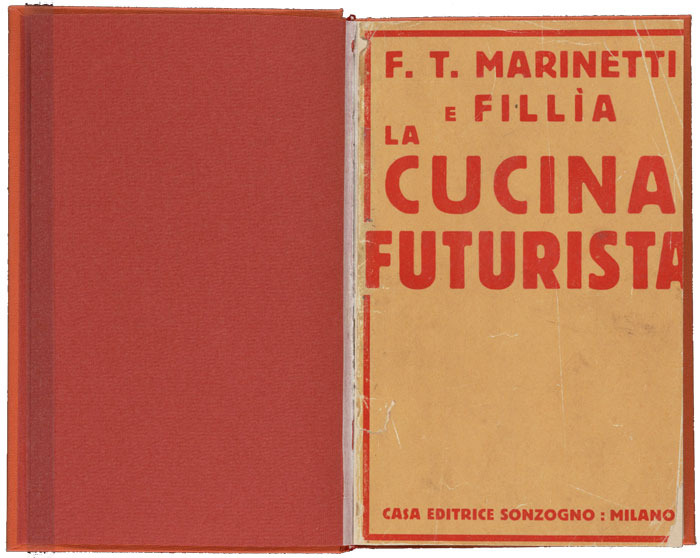Although I’m a voracious consumer of food writing – endlessly pouring over the musings and advice of famous critics, chefs, gourmands, and diet-gurus – I must confess, I rarely cook. Why then, I often wonder, do I derive so much pleasure from looking at recipes I have no intention of trying, and of reading them almost as if they were poems? Simple list poems, but poems nevertheless. All I can tell you is that they satisfy the certain hunger I have to imagine food and to play with this imaginary food. This fantasy space where food and art, cooking and poetry, can intersect is admirably explored by the Italian art theorist and provocateur, Filippo Tommaso Marinetti in La Cucina Futurista — The Futurist Cookbook first published in 1932. It is a deliciously absurd program for revolutionizing and aestheticizing the way we eat.
As one of the founding members of Futurism, an early 20th century art and social movement, Marinetti is best known for his manifestoes and performances praising the virtues of speed, embracing technology, and celebrating war. In The Futurist Cookbook, he brings the full force of his radical and irreverent sensibility not just to the streets, but to the sacred (especially for Italians) ancestral table and kitchen.
As usual, he sets out immediately to shock as many as possible. One diatribe calls for the banning of pasta on the grounds that “it makes people heavy, brutish – deludes them into thinking it is nutritious, makes them skeptical, slow, pessimistic.” In another lecture, he claims: “Pastaciutta … ties today’s Italians with its tangled threads to Penelope’s slow loom and to somnolent old sailing ships in search of wind.” Being of Italian descent myself, I can easily imagine how provocative his words — his whole stance — must have been. Italy is a country that likes to wear its antiquity on its sleeve. Its capital, Rome, is after all nicknamed the Eternal City. With his constant desire to move things forward and away from the past, Marinetti must have seemed quite the contrarian. And to suggest abolishing pasta? Well, I’m not surprised he’s also the author of an essay titled, “The Pleasure of Being Booed.” Of course, Marinetti lost the war on pasta. In our time, aside from a brief moment led by the carb-phobic Dr. Atkins, pasta seems more globally popular than ever.
In another section entitled “The Great Futurist Banquets,” Marinetti tackles the experience of eating out. He describes how he, along with two artist and architect friends, transformed a restaurant in Turin into The Holy Palate, the first ever futurist dining spot. It featured walls covered floor to ceiling with aluminum foil (long before Andy Warhol’s factory) and provided no knives or forks to interfere with customers enjoying the tactile sensation of their food.
There’s always an element of theater in the restaurant business, and Marinetti and his cohorts only amplified it. In fact, as ridiculous as some of the ideas sound, many turned out to be oddly prescient of contemporary trends. The insistence on small portions, exotic ingredients, startling juxtapositions of unlikely flavors, and an emphasis on artistic presentation are all par for the course at many chic eateries. I read recently about a theme restaurant where diners eat in pitch-black total darkness to heighten the taste of their food. Marinetti would have loved it.
The final section of The Futurist Cookbook is fittingly devoted to formulas, a.k.a. recipes, for food and cocktails contributed by various luminaries of the movement. It is worth reading for the hilarious and poetic names alone – dishes like “Sculpted Meat,” Elasticake,” and “Immortal Trout,” to list but a few. I have never tried to prepare any of these, but some sound like they would be perfectly edible, while others seem better left to the imagination. I will let three of them speak for themselves.
The Tummy Tickler
(formula by the Futurist Aeropainter Ciuffo)
A slice of pineapple on which sardines are laid out in rays. The center of the pineapple slice is covered with a layer of tuna on which sits half a nut.
The Excited Pig
(formula by the Futurist Aeropainter Fillia)
A whole salami, skinned, is served upright on a dish containing some very hot black coffee mixed with a good deal of eau de Cologne.
Simultaneous Ice-Cream
(formula by the Futurist word-in-liberty poet, Giuseppe Steiner)
Dairy cream and little squares of raw onion frozen together.
*
I have enjoyed this book for many years, and its sublime goofiness never fails to fill me with wonder. I keep it among my favorite poetry books, right next to the cubist apples, eggs, and milk of Gertrude Stein’s Tender Buttons.
Ordinarily, I’m not a big fan of Marinetti’s work. His hyper-masculine posturing, bombastic style, and fascist politics are a turn-off. But credit where credit is due, the man has written a helluva good cookbook!

Elaine Equi is the author of many collections of poetry including, Voice-Over, which won the San Francisco State Poetry Award; Ripple Effect: New & Selected Poems, which was a finalist for the L.A. Times Book Award and on the short list for The Griffin Poetry Prize; Click and Clone; and most recently, Sentences and Rain. Widely published and anthologized, her work has appeared in The Nation, Poetry, The New Yorker, and several editions of The Best American Poetry. In addition to The New School, she teaches at New York University.
feature image by Feasting Never Stops.


Comments are closed.